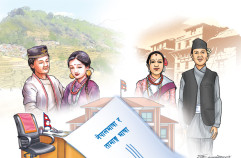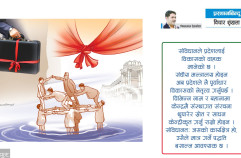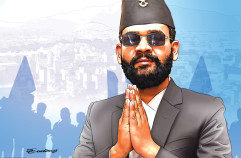Eight years of federalism in Madhesh
We use Google Cloud Translation Services. Google requires we provide the following disclaimer relating to use of this service:
This service may contain translations powered by Google. Google disclaims all warranties related to the translations, expressed or implied, including any warranties of accuracy, reliability, and any implied warranties of merchantability, fitness for a particular purpose, and noninfringement.

Madhesh is considered as the mother of federalism in Nepal. With the rise of democracy in 2007, the Nepal Terai Congress Party was established, which started the debate on federalism in Nepal. The political demands of that party were that Terai should be a province, Madhesi should have reservation in government service and Hindi should be the language of government work.



In the first parliamentary election of 2015, Terai Congress failed to win even one seat, and the issue of federalism was overshadowed. Throughout the Panchayat period, federalism was on the decline. However, towards the end of the Panchayat, the Nepal Sadbhavana Parishad formed under the leadership of Gajendra Narayan Singh revived the issue of federalism. Later, the Maoist People's War brought the federalism debate to a higher level.
Maoist's demand for the formation of autonomous provinces with ethnic and regional identity had caused Nepali society and politics to waver in a new way. However, when the interim constitution was promulgated on January 1, 2063, it remained silent about federalism. The Upendra Yadav-led Madhesi Janadhikhar Forum protested against it. Dozens of Madheshis were martyred in the three-week-long Madhesi rebellion. The then Prime Minister Girija Prasad Koirala had to address twice within a week. In the second speech on January 24th, it was announced that Nepal will now be a republican federal state. Soon after, the interim constitution was amended and federalism was given a constitutional place.
Constitution of Nepal 2072 embodied federalism. Seven provinces were formed including Madhesh. It took seven decades to determine the journey from the beginning of the federalism debate in Nepal to the creation of provinces. Federalism has been practiced in Nepal for eight years. Elections have been held two times each at all three levels of the federal structure. How is it being implemented in Madhesh province, which has a legacy of federalism? What is the state of representation of different social groups in both elections of the three levels? An attempt has been made in this article to discuss the effectiveness and accessibility of the service facilities and government administration provided by the state in the remote villages of Madhesh, ensured by federalism.
Social Structure of Madhesh Province
According to the preliminary results of National Census 2078, Madhesh Province is the most populated province of Nepal. Out of the total 125 castes in Nepal, 180 castes live in this province. All the castes of Madhesh province have been divided into eight different caste groups and analyzed here. 89 percent of the total population in this province is Madhesi community and 11 percent is hill community. The presence of Muslim community is 12 percent. The population of Madhesi Dalit community is 15 percent while Yadav alone is also 15 percent.
Two other groups – Vaishya and Dikka are developing as new social groups. Within the Vaishya community, nine castes (Teli, Sundi, Kalwar, Kanu, Sonar, Haluwai, Bania, Kathbania and Badhai/Barai) have started to be bound by one common identity, mainly from Madhesh. However, even though all these social groups come together and form a new identity, their population comes to 16 percent of the total population of the province. The Dikka are another group consisting of four castes (Dhanuk, Kurmi, Kewat and Amat), which constitute 8 percent of the population. Madhesi tribes including Tharu, Danuwar, Rajvanshi, Urau, Kisan are 6 percent. The presence of Madhesi upper castes (Brahmins, Kayasts, Rajputs, Bhumihars and Devas) is about 3 percent.
New marginalization in politics
There are eight districts in Madhesh province (Saptari, Siraha, Dhanusha, Mahottari, Sarlahi, Rautahat, Bara and Parsa). There are 32 direct seats in the House of Representatives across the province. There are 64 direct seats and 43 proportional seats in the 107-member state assembly. There are a total of 136 municipalities and 1,271 wards in the province.
Analyzing the results of both elections from the perspective of inclusiveness, something becomes clear. First, Dalits, who are a large population, have been elected in very small numbers in all levels of elections. Comparatively, the representation of Muslims and Dikka communities is weak, although they are slightly more than Dalits. The hilly and upper Madheshi castes in Madhesh are slightly more represented in the population. In other previous elections, their representation used to be comparatively higher. In Madhesh, the Yadav and Vaishya communities have won the most elections. The Yadavs are more than twice the population and the Vaishyas have won the elections with almost twice the population.

In the year 2074, no women were elected as federal MPs, while in the year 2079, two women were elected, but there is no significant difference in the state. In 2079, women were elected to 4 positions as heads of local government, but only 1 person won in 2074. When the Madhesh state government introduced the Dalit Empowerment Act in 2076, it was widely discussed. Before the introduction of that law, in the local level elections of 2074, two chiefs and six deputy chiefs were won by the Madhesi Dalit community, but in the elections of 2079, only one chief and two deputy chiefs won. This data has raised questions about the validity of the Dalit Empowerment Act.
efforts and challenges
The only province in Nepal was named Madhesh province based on identity. More than five dozen laws have been passed by the Madhesh State Assembly. Dozens of bills have been proposed. Most of the laws have been brought for the day-to-day operations of the provincial government and its agencies. Some of the Acts are related to the rights (sharing of powers) with the federal government, while some also focus on addressing diversity within the provinces. For example, the State Police Act and the State Civil Service Act deal with the sharing of powers with the federal government. Due to the non-implementation of the Acts and laws that the Federal Government should bring and implement in order to implement those Acts, the State Government is having difficulty in recruiting its own police and other personnel. The state government is demanding loudly from the federal government regarding this matter. But the state government is apathetic in implementing the Dalit Empowerment Act itself. The Dalit Empowerment Act envisages four different types of committees, but that does not seem to be a priority for anyone. The madrasa education bill brought for the upliftment of the Muslim community has been stalled in the state assembly. Madhesh state assembly, government and political parties and leaders are all silent about this.
Geographically, it feels like there are three Madhesh within Madhesh. One is the Madhesh adjacent to the East-West highway, the other is the Madhesh in the southern border region and the Madhesh in between. There is a wide difference in the social structure and presence of the state in the Madhesh of the three regions. Most of the settlements in Madhesh along the highway are new. Due to migration and settlement development promoted by the state during the Panchayat period, many settlements were settled in that region. In that area, the hill community is dominant. Roads are well developed. Therefore, the market also seems to have developed relatively well. State presence is also good.
There are classes in the society, but a big change can be seen in class relations. There is also a good number of educated people living there. First there were those who migrated from the mountains, later the migration also increased from the south. There were many people who read and wrote. The ability to question the functioning of the state has been developed, but the situation in the south is completely opposite. In politics, the dominance of the old rich, elites has continued. There is no questioning in the society. Class, caste and gender discrimination is rampant.
In Madhesh, the presence of the Madhesi community, including Dalits and Muslims, is denser in the southern part than near the highway. The index of poverty and illiteracy is highest in Madhesh province. Many problems have been seen in Madhesh province in terms of service facilities provided by the local government to the common citizens. Madhesh province has the highest number of municipalities across Nepal that do not pass policies and programs within the stipulated time and cannot bring budgets. Every year this problem repeats itself. It is found that relatively good service is provided in the ward and municipality offices located in the highway area. The decision-making process in government affairs there seems to be transparent and effective compared to the south. The working style of the ward office in the southern part is comparatively less impressive. The condition of schools in southern municipalities is even worse. Students studying in public schools are mostly from poor and Dalit families. Those who donated land to the school in the past, today their branch children are keeping their eyes on the property and manpower of that school. As the governance of the school is currently under administration, their children do not study in that school. Those who study have nothing going on in their parents' school. Madhesh's literacy rate and other indicators of development are poor due to the poor condition of education in the south.
After seven decades of debate and efforts, Nepal has been able to practice federalism. Federalism aims to give a dignified life to the people of every section of the society, provide easy access to state service facilities and ensure everyone's participation in the decision-making process. Madhesh got recognition, the Madhesh government is continuing under the leadership of Madheshi leaders and Madheshi party. The government of Madhesh state was expanded dozens of times, but till date not a single person from the Dalit community has become a minister. The presence of marginalized communities in the Union, State and local governments has always been weak. The decision-making process of the government at all levels remains opaque and is controlled by the elders.
The leaders and parties of Madhesh who speak loudly with Kathmandu for their rights are especially double-minded when it comes to giving rights and opportunities to minorities and marginalized people in Madhesh. This will increase the new marginalization that has started within Madhesh. The country and Madhesh are not in anyone's long-term interest. All parties should think about this in time.
– Saha, who has MPhil in Sociology, is associated with Nepal Madhesh Foundation.
प्रकाशित : चैत्र १५, २०८० ०८:५२

 १७.१२°C काठमाडौं
१७.१२°C काठमाडौं














